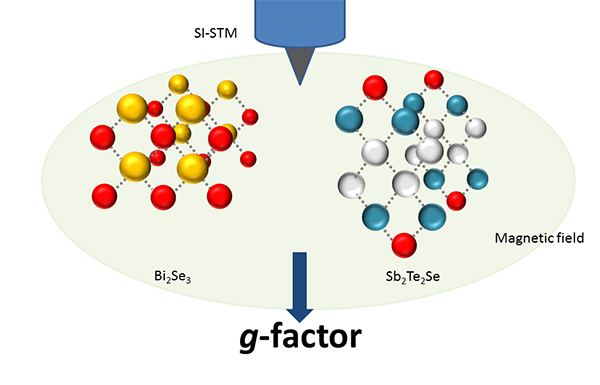Towards Controlling the Electronic Surface Structure of Materials
Published: April 19, 2016
Tokyo Tech researchers measure the Zeeman effect of topological surface states.
Topological insulators are materials that have an electronically insulating interior and an electronically conductive exterior. Much effort has gone into finding and researching the properties of these topological isolators, as they have many uses in potential applications such as quantum computers. An important property of these materials is the Zeeman effect, which is the coupling of spins with a magnetic field. The magnitude of the Zeeman effect is influenced by the magnetic field that has been applied to the material, and an electron "g-factor". Therefore, to influence the topological surface state of a topological insulator through the Zeeman effect, it is important to determine its g-factor. However, studies to determine the g-factor of the topological surface states of materials have yielded inconsistent results.
A new method of measurement
A collaboration combining the expertise of researchers from Tokyo Tech (led by Prof. Takao Sasagawa), RIKEN (led by Dr. Tetsuo Hanaguri) and other institutes recently used spectroscopic imaging scanning tunnelling microscopy (SI-STM) to determine the g-factors of the topological surface states of topological insulators Bi2Se3 and Sb2Te2Se, and reported their findings in Nature Communications.
SI-STM can probe electronic states in a wide energy range with high spatial and energy resolution, so it can be used to study the electronic configuration of topological insulators even if they contain defects. The team developed a methodology using SI-STM to unambiguously observe the g-factor of the topological surface state of Bi2Se3 and Sb2Te2Se.
Figure.
Spectroscopic imaging scanning tunnelling microscopy used to determine the g-factor of Bi2Se3 and Sb2Te2Se.
Calculating the g-factor
The collaboration first modelled the Zeeman effect of a topological surface state to develop a method to analyze their SI-STM data accounting for external effects. They performed SI-STM measurements using crystals of Bi2Se3 and Sb2Te2Se, a tungsten tip, and a magnetic field applied perpendicular to the sample crystal. By accounting for and removing the influence of external effects, the researchers were able to determine the genuine g-factors of Bi2Se3 and Sb2Te2Se from SI-STM measurements.
Interestingly, the determined g-factors for Bi2Se3 and Sb2Te2Se were quite different despite their similar band dispersions and effective masses. The difference might be because of the different constituent elements of the materials. This strong dependence of g-factor on material type has massive potential implications for the development of topological insulators with designed spin states, as the g-factor of topological surface states could potentially be controlled by modifying the chemical composition of the topological insulators. This knowledge could open the door to new, high-quality material for use in future applications such as spintronic devices and quantum computing.
Reference
Authors: |
Ying-Shuang Fu1,2, Tetsuo Hanaguri2, Kyushiro Igarashi3, Minoru Kawamura2, Mohammad Saeed Bahramy2,4 and Takao Sasagawa3 |
Title of original paper: |
Observation of Zeeman effect in topological surface state with distinct material dependence |
Journal: |
Nature Communications 7, 10829 (2016) |
DOI : |
|
Affiliations: |
1School of Physics and Wuhan National High Magnetic Field Center, Huazhong University of Science and Technology,
2RIKEN Center for Emergent Matter Science,
3Materials and Structures Laboratory, Tokyo Institute of Technology,
4Department of Applied Physics, University of Tokyo |
. Any information published on this site will be valid in relation to Science Tokyo.



